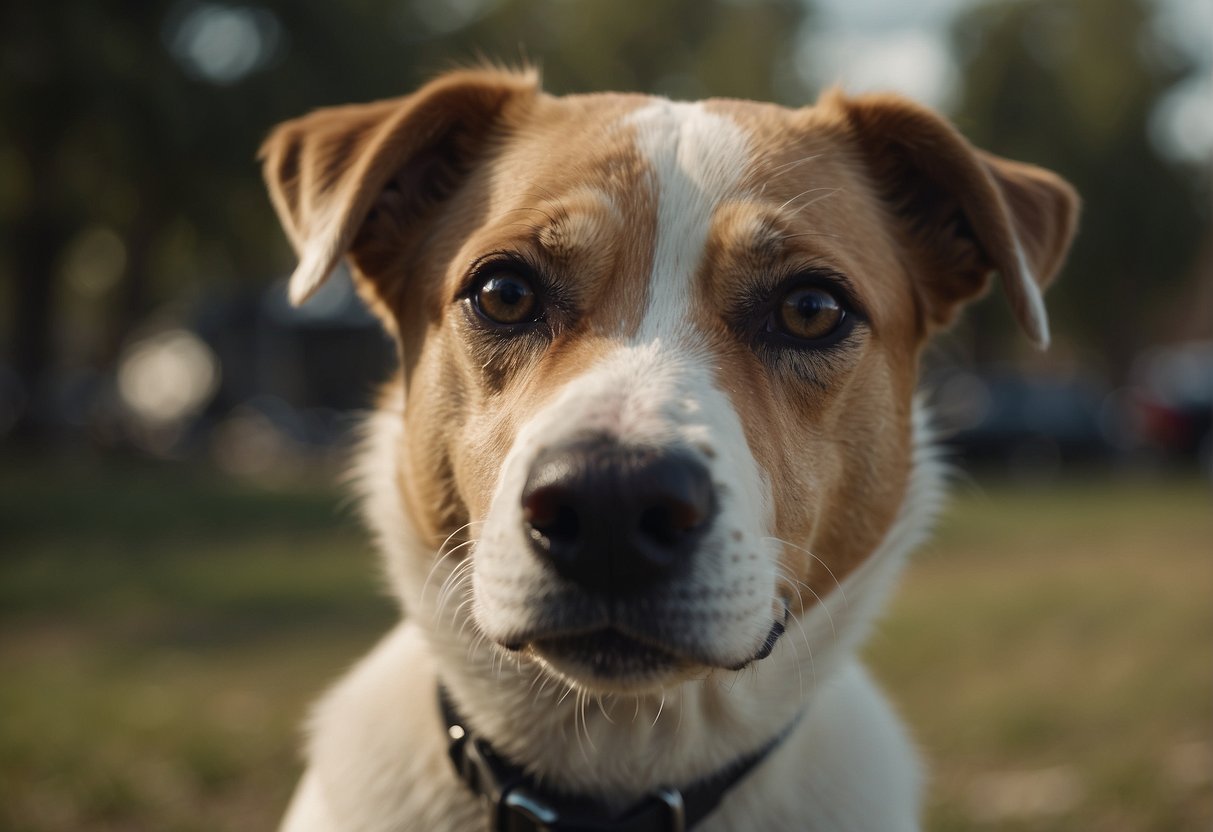When it comes to our furry friends, their well-being is often a top priority for any dog owner.
Recognizing changes in a dog’s health can be challenging, especially with conditions that aren’t always immediately apparent, like vision loss.
Dogs rely heavily on their sense of sight, alongside their keen senses of smell and hearing.
So, when a dog starts experiencing vision problems or blindness, their behavior and habits may change.
Noticing these subtle differences early can make a significant difference in managing their condition and maintaining a good quality of life.

Clues that a dog might have vision problems can manifest in several ways.
Dog owners might observe that their pet is more hesitant when navigating familiar spaces, or they may notice their dog startle more easily when approached unexpectedly.
Physical signs are also indicators; for example, a dog’s eyes may appear cloudy or there may be visible changes in eye color or brightness, which can be symptomatic of underlying eye conditions.
It’s critical for dog owners to keep an eye out for these signs and consult a veterinarian if they suspect their dog’s vision is deteriorating.
Early detection of vision issues can provide more options for management and care, potentially slowing down the progression of vision loss.
Moreover, understanding how to adapt to a dog’s changing needs can ensure a supportive environment for a sight-impaired pet.
Early Signs of Vision Problems

When a dog begins to experience vision problems, they may show signs through altered behaviors, physical symptoms, and difficulty interacting with their environment.
Recognizing these signs early can help a dog owner seek timely advice from a veterinarian and ensure their pet’s comfort and safety.
Behavioral Changes
Dogs with vision loss may exhibit changes in behavior that signal their difficulty seeing.
Owners might notice their dog:
- Hesitation: They become more cautious, hesitating to jump onto furniture or navigate stairs.
- Anxiety: Increased anxiety or unwillingness to play in new environments.
- Startling Easily: They may startle more easily when approached unexpectedly.
Physical Symptoms
Visible physical symptoms can be apparent in dogs experiencing vision impairment. These include:
- Discharge: Look for any unusual discharge coming from the eyes.
- Redness: The white of the eye may turn red due to strain or inflammation.
- Swelling: Examine for swelling around the eyes, which can indicate discomfort or pain.
Environmental Challenges
Dogs with vision difficulties may face challenges interacting with their environment. Signs include:
- Bumping Into Objects: They may seem clumsy or bump into furniture or walls.
- Reluctance to Explore: There can be a newfound reluctance to explore unfamiliar places, showing a lack of comfort in new settings.
By paying close attention to these signals, owners can provide the necessary support and consult with a veterinarian to manage their dog’s vision health effectively.
Common Eye Conditions in Dogs

Eye health is critical for dogs, and being aware of common eye conditions can help owners detect and address issues early.
These conditions range from genetic disorders to age-related diseases and environmental factors, influencing the well-being of a dog’s visionary system.
Genetic Disorders
Hereditary eye conditions are prevalent in some dog breeds, and recognizing them is essential for prompt treatment.
For instance, Progressive Retinal Atrophy (PRA) is a genetic condition leading to blindness due to retina degeneration.
Breeds such as the Labrador Retriever and the Cocker Spaniel are commonly affected.
Another hereditary disorder, Cataracts, can cause cloudiness in the lens, potentially leading to vision loss.
These conditions are often detected through early screening by a veterinarian.
Age-Related Diseases
As dogs age, they are more likely to experience vision problems.
Age-Related Cataracts often develop, causing significant vision impairment.
Likewise, Sudden Acquired Retinal Degeneration Syndrome (SARDS) is a condition that can abruptly cause blindness in older dogs.
While the exact cause of SARDS remains unknown, it has a profound impact on a senior dog’s quality of life and ability to navigate their environment.
Environmental Factors
Eye problems in dogs also arise from environmental factors such as injuries or exposure to irritants.
Corneal ulcers are painful open sores on the cornea often caused by trauma or infection.
Dogs exposed to harsh chemicals, physical harm, or foreign objects are at risk.
In severe cases, conditions like glaucoma, which is an increase in eye pressure, can develop if the protective mechanisms of the eye are compromised due to environmental damage.
Monitoring a dog’s surroundings and preventing exposure to harmful situations is crucial to avoid these painful issues.
Diagnosis and Veterinary Care

When a dog experiences vision problems, prompt diagnosis and veterinary care are crucial.
The care begins with a thorough eye examination and often involves specialized diagnostic tests as recommended by a veterinarian or veterinary ophthalmologist.
Examination Techniques
The primary step in diagnosing vision issues in dogs is a comprehensive eye examination.
A veterinarian will often perform basic tests to assess the dog’s vision and inspect the physical condition of the eyes.
They look for signs of cataracts which may appear as a cloudy film over the eye, possibly indicating diabetes if found in conjunction with other symptoms.
A Schirmer tear test may also be conducted to determine tear production, which can indicate diseases such as dry eye.
The vet may also check for redness, which could be a symptom of inflammation or other eye disorders.
Observing the dog’s ability to track and follow objects helps in assessing their vision capabilities.
Specialized Diagnostics
If the initial exam indicates a problem, the dog may be referred to a veterinary ophthalmologist for more advanced diagnostics, such as:
- Tonometry: Measuring intraocular pressure to test for glaucoma.
- Ophthalmoscopy: Evaluating the inside of the eye, including the retina and optic nerve.
- Ultrasonography: Using high-frequency sound waves to view the internal structures of the eye, which can reveal issues not visible in a regular examination.
These tests can help to diagnose underlying conditions that might lead to vision loss, such as diabetes, cancer, liver disease, or kidney disease.
Recognizing these issues early can prevent or mitigate blindness and help manage vision loss in dogs effectively.
Treatment Options

When a dog is diagnosed with a vision impairment, a veterinarian will typically recommend a treatment plan tailored to the specific eye condition.
Treatment options can range from medical interventions to surgical procedures, and it is essential to consider supportive care as part of the dog’s overall wellness strategy.
Medical Interventions
Depending on the diagnosis, medications may be prescribed to manage the eye condition. These can include:
- Eye drops: to reduce inflammation, combat infection, or decrease pressure.
- Oral medications: such as antibiotics or anti-inflammatory drugs, if an underlying systemic condition is contributing to the eye problem.
Consistent administration of medicine is crucial, and a veterinarian will provide instructions on dosage and frequency.
Surgical Procedures
For certain conditions like cataracts, surgery may be the most effective treatment.
Surgical interventions might involve:
- Cataract surgery: to remove the opaque lens and potentially restore vision.
- Procedures for glaucoma: aimed at reducing intraocular pressure to preserve sight.
Post-surgery, the recovery period is critical, and dogs may require extra care and observation to ensure proper healing.
Supportive Care
Beyond medical and surgical options, supportive care plays a significant role in helping dogs with vision loss. This may include:
- Modifying the home environment: to prevent injuries and make navigation easier.
- Training and therapy: to help dogs use other senses to compensate for vision loss.
Therapy can enhance a dog’s quality of life, providing comfort and adjustment to vision changes.
Adapting to Vision Loss

When a dog experiences vision loss, whether due to aging, injury, or visual impairment, adapting their living environment can significantly enhance their comfort and safety.
Focused modifications, training methods, and safety precautions can help manage their condition effectively.
Home Modifications
Adjustments around the home can make a world of difference for dogs with vision problems.
Stairs can become a significant hazard, but installing ramps or dog stairs assists them in navigating to higher spaces safely.
Owners should consider rearranging furniture to create a clear path and maintain a consistent layout to prevent injury from bumping into objects.
- Clear Pathways: Keep floors clear of obstructions.
- Consistency: Avoid frequently moving furniture.
- Accessibility: Provide ramps for access to favorite spots.
Training and Communication
Training and communication need to adapt to a dog’s changing capabilities.
Teaching voice commands becomes crucial as reliance on visual cues decreases.
Owners can use tactile training techniques, like a touch on the shoulder to sit or a nudge on the back to lie down.
This fosters a deeper bond and helps the dog navigate their world without sight.
- Voice Commands: Use clear, consistent commands for guidance.
- Physical Cues: Incorporate touches or vibrations as signals.
Safety Measures
Preventive safety measures minimize the risk of trauma and enhance a visually impaired dog’s well-being.
Owners should block off dangerous areas such as pools or stairs with baby gates or barriers.
Padding sharp corners on furniture can also prevent injuries.
Creating a safe and familiar environment is key to helping a dog with vision loss live a full life.
- Secure Environment: Install gates to block hazardous areas.
- Padding: Cushion furniture edges to protect from scrapes.















